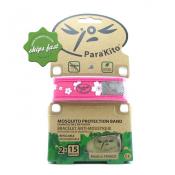What are the different types of insect repellent?
You can choose from these forms, depending on your preference:
Spray in the form of oil or liquid - a very common form of insect repellent, this can be sprayed on clothing or directly onto skin. Most spray repellent preparations contain concentrated amount of DEET. Insect repellents with DEET are considered to be effective even after several hours of walking through places that are heavily infested with mosquitoes.
- Cream or lotion - are most effective when applied directly to the skin and are rubbed to create a repellent barrier. You can use this in combination with mosquito repellent clothing and are usually made with natural ingredients. These usually have a very minimal scent or sometimes an undetectable scent.
- Insect or mosquito repellent clothing - specially designed clothing materials with tight fibre weave infused with long lasting insect repellent. It is a great alternative to other insect repellent forms because it can protect you from mosquito or insect bites everyday.
- Mosquito patch - is the newest kind of insect repellent. It is made of 100% natural and safe vitamin B1. It is small, transdermal skin patch that is very easy to use. Simply slap it onto your skin and it does its work naturally.
- Mosquito repelling bracelets - are specially designed clip on bracelets or simply clip on devices that are made with either chemical or natural insect repellent pellets inside. These are ideal for babies or those who prefer not to apply anything on their skin. These can be used either as a bracelet or clipped on bags, chairs, prams etc.
- Mosquito repellent devices - are various types of devices that emit a repellent fragrance usually through the process of burning. These may come in the form of candles, coils or Thermacell products.
- Electronic repellents - emit ultrasonic sound as a deterrent to bugs and insects.
- Vitamin B - Thiamin - This product is rumored to put the mosquitos off the smell of your blood.
What are the active ingredients used in insect repellents?
DEET - (N,N-diethyl-3-methylbenzamide) is a chemical that has been approved for use since 1957. It is considered as reliable and highly effective in repelling insects of many kinds. It is present in most forms of insect repellents. Some products contain a higher percentage of DEET than others. Its concentration content signifies the length of protection time it offers. The higher the concentration, the longer protection time it provides.
Picardin - also known as KBR 3023 is another active ingredient used in insect repellents and is also an effective alternative to DEET. It offers long lasting protection against mosquito bites. It has been widely used since 1998. It differs from DEET on several accounts: less odour, does not cause skin irritation and no adverse effect on plastics.
It also offer long lasting protection.
Permethrin - is known as an effective pesticide and is also used in insect repellent. Compared to the first two active ingredients, permethrin is not used on the skin but rather used to treat clothes that repel insects of many kinds. It can retain its potency for at least two weeks even through several washings. It can also be used or applied on tent walls and mosquito nets. Clothing treated with permethrin used in combination with products containing DEET applied on skin offers excellent protection even in demanding conditions. Best when camping in forests or mountains.
Lemon Eucalyptus Oil - is also considered as a natural insect repellent. This has been tested against mosquitoes and found in the US to provide similar protection to repellents containing low concentrations of DEET. PMD is the synthetic form of the chemical derived from oil of lemon eucalyptus. However the use of this product is not advised for those ages 3 years old and below.
IR-3535 - is another active ingredient used in insect repellents and it offers broad spectrum protection from several insects including mosquitoes, deer ticks, and biting flies. It offers reasonably long protection comparable to DEET thus offering a great alternative for those seeking non-DEET products.
Plant Based Repellents - examples of these are citronella, geranium, basil, garlic and peppermint. Insect repellent plants generally provide quite limited protection against mosquitoes. Usually offering protection for only 2 hours and therefore needing constant reapplying.
Tips for choosing the best repellent
To help you choose the insect repellent product that is best suited for you, you can start by identifying the following:
- Type of insect you want protection from
- How long do you need protection?
- What active ingredient do you prefer?
- Other product specific information that may be useful for you (e.g. allergies to consider with certain ingredients)
- Consider the kind of activity you will be engaging in and the length of exposure you will have to insects.
Using insect repellents with children*
Dos:
- Read and follow the directions and precautions on the label
- Only apply insect repellents on the outside of children's clothing and on exposed skin. NB: Permethrin-containing products should not be applied to the skin.
- Spray repellents in open, well ventilated areas to avoid breathing them in.
- Only use enough repellent to cover your child's clothing and exposed skin - using more does not make the repellent more effective. Avoid reapplying unless definitely needed.
- Help young children to apply their insect repellent and supervise older children when using these products.
- Wash your children's skin with soap and water to remove any repellent when they return indoors. Wash their clothing before they wear it again.
Dont's:
- Do not apply insect repellent on children younger than 2 months.
- Never spray insect repellent directly onto your child's face. Instead, spray a little on your hands first and then rub it on your child's face, avoiding the eyes and mouth.
- Never spray insect repellent on cuts, wounds, or irritated skin.
- Avoid using products that combine DEET with sunscreen. The DEET can make the sun protection factor (SPF) less effective, meaning these products can overexpose your child to DEET because the sunscreen needs to be reapplied often.
*Source: https://www.healthychildren.org/English/safety-prevention/at-play/Pages/Insect-Repellents.aspx Page updated 06/04/18 12:47:36 p.m.







































